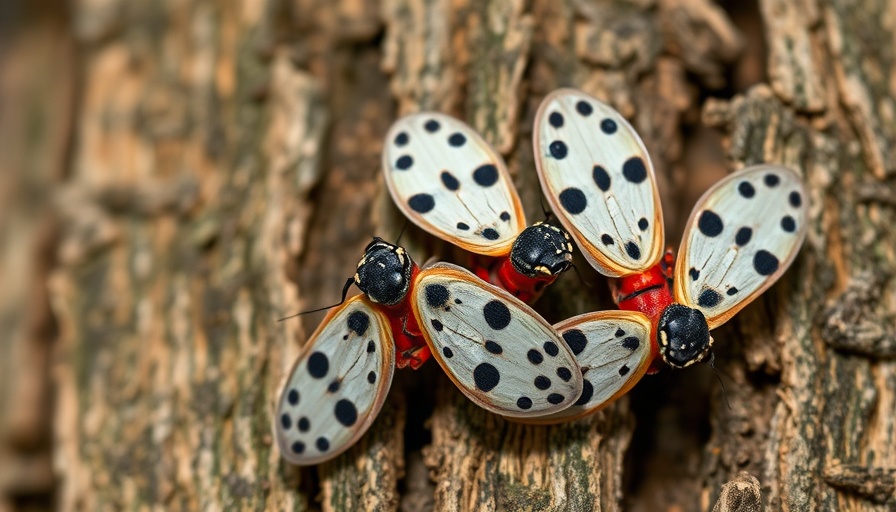
Understanding the Spotted Lanternfly: A Beautiful Yet Destructive Pest
The Spotted Lanternfly (SLF) is gaining notoriety across the U.S. since its accidental introduction about a decade ago. With its stunning appearance—a chunky body featuring a black head, speckled gray forewings, and vibrant red hindwings—it might charm at first glance. However, this invasive planthopper poses significant threats to agriculture and native plant life, making it essential for homeowners and residents to familiarize themselves with its lifecycle and impact.
Crisis and Response: Quarantine Measures in Affected States
As Spotted Lanternflies continue to multiply, states like Ohio have taken decisive actions to combat the infestation. With 18 of Ohio's 88 counties currently under quarantine, residents are urged to identify and report sightings. Entomologist Emma Grace Crumbley notes, “Many states are urging citizens to learn how to identify their eggs, nymphs, and adults, and squish them if seen.” This community involvement is crucial as the insects continue to spread due to their limited natural predators in the region.
How to Spot and Control the Spread of Spotted Lanternflies
Identifying Spotted Lanternflies can be straightforward if you know what to look for. Adult SLFs are roughly 1 inch long, featuring a pattern that allows them to blend in with their surroundings while their striking hindwings are tucked away. Nymphs present a different challenge, appearing as either bright red with black dots or black with white dots. Among the effective actions homeowners can take are:
- **Tracking:** Regularly inspecting your property for any signs of SLFs or their eggs, which resemble gray, sticky masses.
- **Reporting:** Alerting local agricultural authorities if seen.
- **Control Measures:** Residents can squish SLFs, use sticky traps, and avoid moving potentially infested materials like firewood.
The Economic Threat of Spotted Lanternflies
While Spotted Lanternflies are not harmful to humans or pets, their impact on agriculture is a significant concern. They thrive on hardwood trees, fruit trees, and various crops, particularly affecting those such as grapes, apples, hops, and grains. Their feeding can lead to a decline in crop quality, resulting in increased economic woes for farmers. Knowledge about their dangers is crucial for minimizing agricultural loss.
Future Predictions: The Continued Expansion of Spotted Lanternflies
With their rapid proliferation since their first sighting in Pennsylvania in 2014, Spotted Lanternflies are expected to expand even further across the U.S. “They have spread like wildfire,” affirms Joe Malinowski from Pest Authority. As climate conditions remain favorable for their survival and reproduction, preventative measures will become increasingly necessary.
Community Involvement: Essential for Effective Action
The fight against Spotted Lanternflies is not solely in the hands of state authorities. Residents play a critical role in managing this invasive species. By maintaining vigilance and participating in local monitoring efforts, communities can mitigate the potential damages caused by these pests. Spreading awareness and knowledge about the species can empower everyone to take action.
Final Thoughts on Protecting Our Environment
By learning about Spotted Lanternflies and understanding their influence on the environment and agriculture, residents can contribute to stopping their spread. Implementing homeowner initiatives and engaging with local agricultural programs can lead to collective success in managing this invasive threat. We must work together to protect our crops and natural ecosystems.
 Add Row
Add Row  Add
Add 



Write A Comment